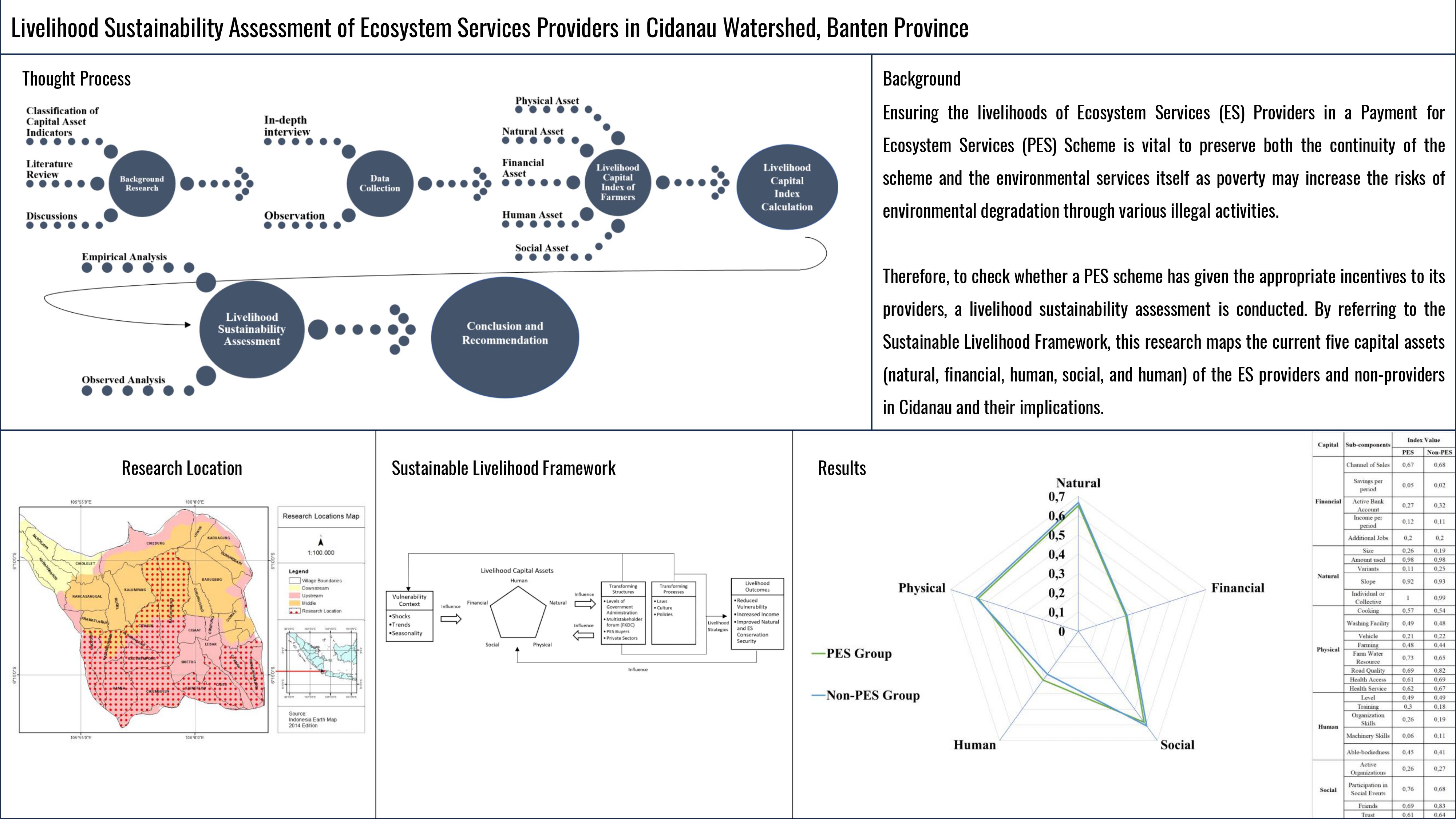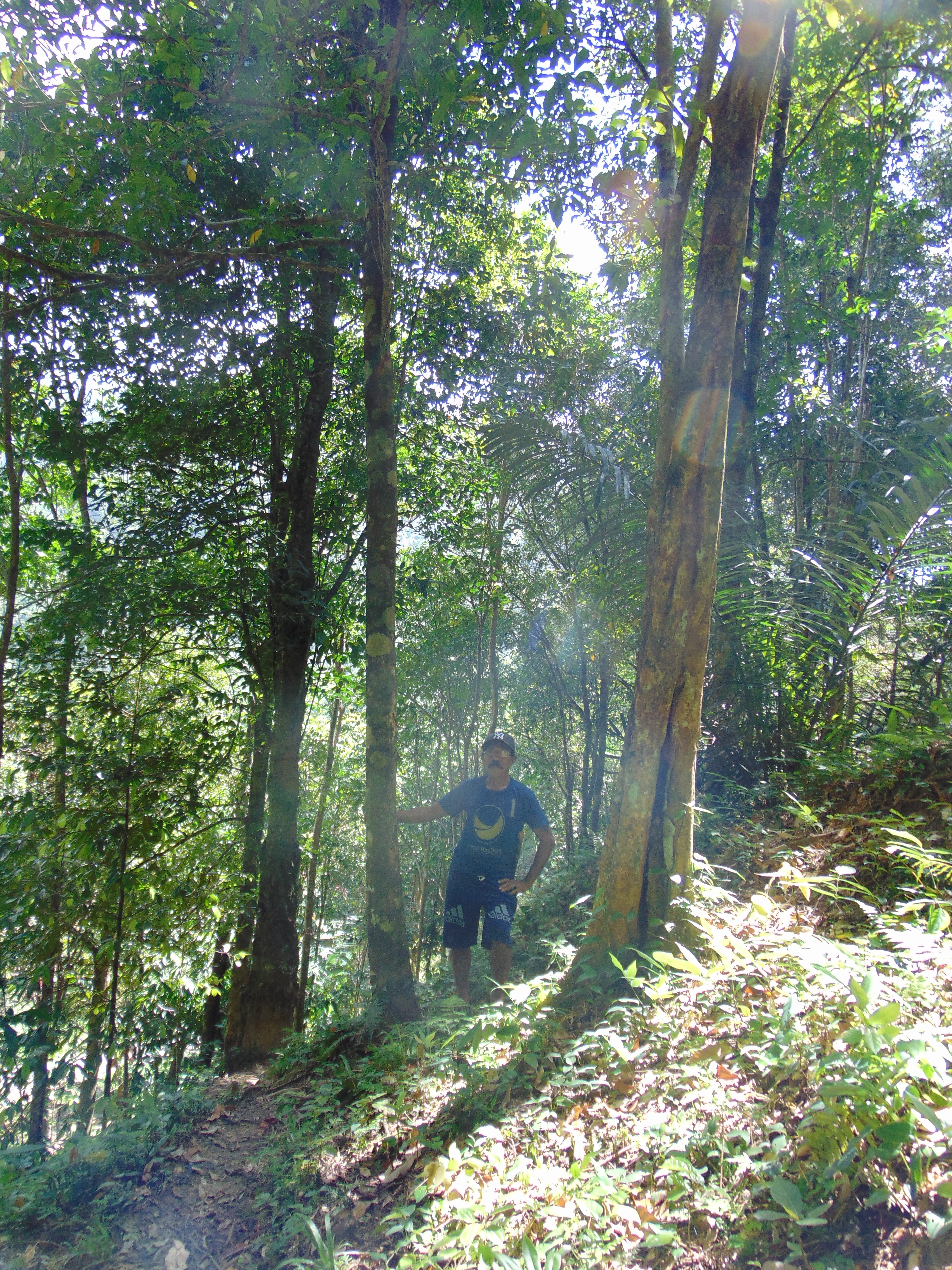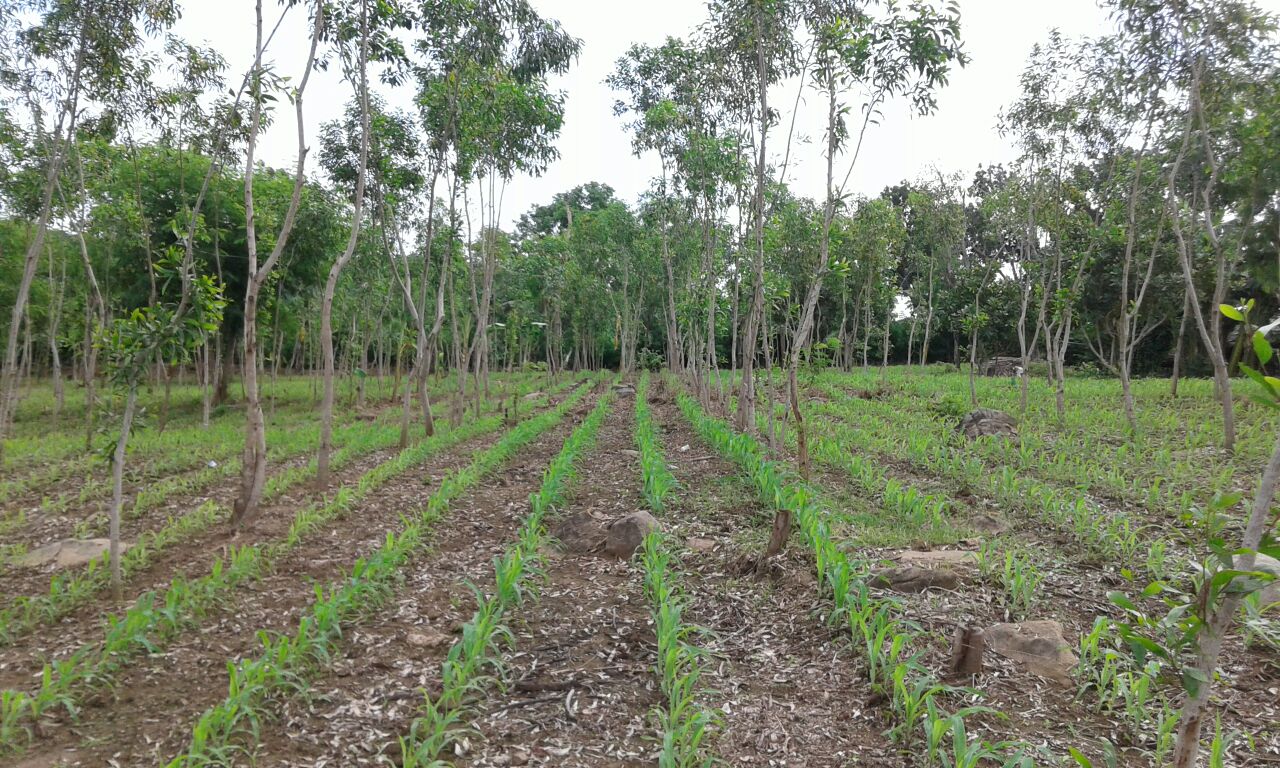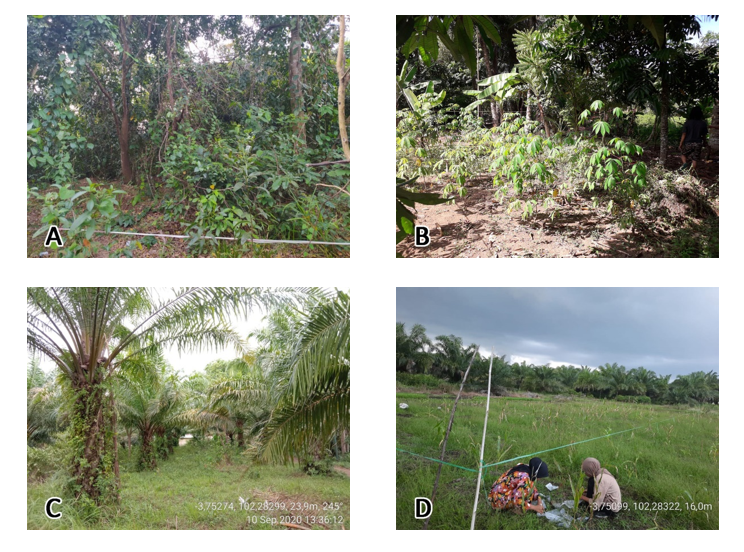Growth of Betung Bamboo (Dendrocalamus asper) and Food Crop Production Under Agroforestry Bamboo Systems
Abstract
One of the main species in community forests is betung bamboo (Dendrocalamus asper). Optimizing land use under bamboo can be achieved by cultivating food crops. This research aimed to determine the growth of betung bamboo and the production of food crops. The experimental design used a split plot design with four cultivation patterns as the main plots: agroforestry bamboo pattern i.e. agroforestry bamboo + rice (P1), agroforestry bamboo + rice + cassava (P2), agroforestry bamboo + rice + taro (P3), and mixed food crops (rice + cassava + taro) (P4), while the subplots were rice varieties: rindang 2 (V1), protani (V2), and unsoed (V3). The observed parameters were bamboo growth, soil fertility, and food crop production. The results showed that seven-year-old betung bamboo had an average of 6.01 mature stems per clump, an average plant height of 7.23 m, and a stem diameter of 7.12 cm. The numbers of young stems and shoots per clump was 1.45 and 3.71. The highest betung bamboo growth was in the agroforestry pattern (length: 8,49 m, diameter: 7.17 cm, thickness: 1.95, total weight: 21.31 kg). The highest rice yield was observed in the P2V1 treatment (4.17 kg). The highest cassava tuber yield per plant was observed in P4 (2.12 kg). The taro tuber yield was relatively higher in the agroforestry pattern with a distance of >1 m from the bamboo clump (0.52 kg plant-1). The land equivalent ratio (LER) and area time equivalent ratio (ATER) of bamboo and food crop agroforestry have a value above 1, so it is more efficient in land.
References
Abbas, A. M., & Amanabo, U. H. (2017). Harnessing the economic and environmental benefits of bamboo in Nigeria. Alanya Akademik Bakış, 1(3), 39–47. https://doi.org/10.29023/alanyaakademik.335480
Akoto, D. S., Partey, S. T., Denich, M., Kwaku, M., Borgemeister, C. N., & Schmitt, C. B. (2020). Towards bamboo agroforestry development in Ghana: Evaluation of crop performance, soil properties and economic benefit. Agroforestry Systems, 94(5), 1759–1780. https://doi.org/10.1007/s10457-020-00493-7
Ananfack, G. R. K., Tientcheu, M. L. A., & Temgoua, E. (2023). Farmers’ local knowledge of soil fertility in bamboo plantations in the Western Highlands, Cameroon. Advances in Bamboo Science, 4, 100031. https://doi.org/10.1016/j.bamboo.2023.100031
Aribal, L. G., Parlucha, J. A., Gelaga, J. N., & Aguinsatan, R. G. (2022). Influence of abiotic factors on growth and development of giant bamboo (Dendrocalamus asper) in Bukidnon, Philippines. Journal of Tropical Forest Science, 34(1), 63–73. https://doi.org/10.26525/jtfs2022.34.1.63
Azzahra, H., Lubis, Y. D. M., Hartanti, S. D., & Purnaningsih, N. (2020). Teknik budidaya tanaman talas (Colocasia esculenta Scho) sebagai upaya peningkatan hasil produksi talas di Desa Situgede. Jurnal Pusat Inovasi Masyarakat, 2(3), 412–416.
Bammite, D., Matthews, P. J., Dagnon, D. Y., Agbogan, A., Odah, K., Dansi, A., & Tozo, K. (2018). Constraints to production and preferred traits for taro (Colocasia esculenta) and new cocoyam (Xanthosoma mafaffa) in Togo, West Africa. African Journal of Food, Agriculture, Nutrition and Development, 18(2), 13388–13405. https://doi.org/10.18697/ajfand.82.17360
Barnes, T., Parajuli, R., Leggett, Z., & Suchoff, D. (2023). Assessing the financial viability of growing industrial hemp with loblolly pine plantations in the southeastern United States. Frontiers in Forests and Global Change, 6. https://doi.org/10.3389/ffgc.2023.1148221
Bian, F., Zhong, Z., Li, C., Zhang, X., Gu, L., Huang, Z., Gai, X., & Huang, Z. (2021). Intercropping improves heavy metal phytoremediation efficiency through changing properties of rhizosphere soil in bamboo plantation. Journal of Hazardous Materials, 416, 125898. https://doi.org/10.1016/j.jhazmat.2021.125898
Biswas, B., Chakraborty, D., Timsina, J., Bhowmick, U. R., Dhara, P. K., Ghosh (Lkn), D. K., Sarkar, A., Mondal, M., Adhikary, S., Kanthal, S., Patra, K., Sarkar, S., Parsad, R., & Ray, B. R. (2022). Agroforestry offers multiple ecosystem services in degraded lateritic soils. Journal of Cleaner Production, 365, 132768 https://doi.org/10.1016/j.jclepro.2022.132768
Boampong, R., Boateng, S. K., Adu Amoah, R., Adu Gyamfi, B., Aboagye, L. M., & Ansah, E. O. (2020). Growth and yield of taro (Colocasia esculenta (L) Schott.) as affected by planting distance. International Journal of Agronomy, 2020, 8863099. https://doi.org/10.1155/2020/8863099
[BPS] Badan Pusat Statistik. (2021). Jumlah penduduk miskin menurut wilayah. Retrieved from https://www.bps.go.id/indicator/23/183/1/jumlah-penduduk-miskin-menurut-wilayah.html
[BPS] Badan Pusat Statistik Kabupaten Ciamis. (2018). Kecamatan Rajadesa dalam angka. Ciamis: BPS Ciamis.
Caicedo-Vargas, C., Pérez-Neira, D., Abad-González, J., & Gallar, D. (2022). Assessment of the environmental impact and economic performance of cacao agroforestry systems in the Ecuadorian Amazon region: An LCA approach. Science of the Total Environment, 849, 157795. https://doi.org/10.1016/j.scitotenv.2022.157795
Camargo, B., Rovedder, A. P. M., Felker, R. M., Piaia, B. B., Stefanello, M. de M., Procknow, D., & Croda, J. P. (2022). Effect of chemical and mechanical management of bamboo on seed rain in riparian areas. Forest Ecology and Management, 508, 120025. https://doi.org/10.1016/j.foreco.2022.120025
Capellesso, S. E., Artusi, Á. C., Marques, M. C. M., Dalastra, C. H., Haiduki, L., Bayer, C., & Sausen, T. L. (2022). Effects of a native bamboo species on tree regeneration diversity of a subtropical Atlantic forest. Forest Ecology and Management, 524, 120530. https://doi.org/10.1016/j.foreco.2022.120530
Chavan, S. B., & Dhillon, R. S. (2019). Doubling farmers’ income through Populus deltoides-based agroforestry systems in Northwestern India: An economic analysis. Curent Science, 117(2), 219–226. https://doi.org/10.18520/cs/v117/i2/219-226
Deng, F., Li, B., Yuan, Y., He, C., Zhou, X., Li, Q., Zhu, Y., Huang, X., He, Y., Ai, X., Tao, Y., Zhou, W., Wang, L., Cheng, H., Chen, Y., Wang, M., & Ren, W. (2022). Increasing the number of seedlings per hill with reduced number of hills improves rice grain quality by optimizing canopy structure and light utilization under shading stress. Field Crops Research, 287, 108668. https://doi.org/10.1016/j.fcr.2022.108668
Derebe, A. D., Gobena Roro, A., Tessfaye Asfaw, B., Worku Ayele, W., & Hvoslef-Eide, A. K. (2019). Effects of solar UV-B radiation exclusion on physiology, growth and yields of taro (Colocasia esculenta (L.)) at different altitudes in tropical environments of Southern Ethiopia. Scientia Horticulturae, 256, 108563. https://doi.org/10.1016/j.scienta.2019.108563
Dettweiler, M., Wilson, C., Maltais-Landry, G., & MacDonald, G. (2023). Cassava-legume intercropping is more beneficial in low-input systems: A meta-analysis. Field Crops Research, 300, 109005. https://doi.org/10.1016/j.fcr.2023.109005
Dev, I., Ram, A., Ahlawat, S. P., Palsaniya, D. R., Singh, R., Babanna, S. K., Newaj, R., Dwivedi, R. P., Kumar, R. V., Yadav, R. S., Chand, L., Kumar, D., & Prasad, J. (2020). Bamboo-based agroforestry system (Dendrocalamus stritus + sesame – chickpea) for enhancing productivity in semi-arid tropics of central India. Agroforestry Systems, 94, 1725–1739. https://doi.org/10.1007/s10457-020-00492-8
Dubiez, E., Freycon, V., Marien, J. N., Peltier, R., & Harmand, J. M. (2019). Long term impact of Acacia auriculiformis woodlots growing in rotation with cassava and maize on the carbon and nutrient contents of savannah sandy soils in the humid tropics (Democratic Republic of Congo). Agroforestry Systems, 93, 1167–1178. https://doi.org/10.1007/s10457-018-0222-x
Ekawati, D., Karlinasari, L., Soekmadi, R., & Machfud. (2023). A model of integrated community-based bamboo management for the bamboo industry in Ngada Regency, East Nusa Tenggara, Indonesia. Sustainability, 15(2), 977. https://doi.org/10.3390/su15020977
Enesi, R. O., Hauser, S., Pypers, P., Kreye, C., Tariku, M., & Six, J. (2022). Understanding changes in cassava root dry matter yield by different planting dates, crop ages at harvest, fertilizer application and varieties. European Journal of Agronomy, 133, 126448. https://doi.org/10.1016/j.eja.2021.126448
Fuke, P., T, M. M., Kumar, M., Sawarkar, A. D., Pandey, A., & Singh, L. (2021). Role of microbial diversity to influence the growth and environmental remediation capacity of bamboo: A review. Industrial Crops and Products, 167, 115367. https://doi.org/10.1016/j.indcrop.2021.113567
Gai, X., Zhong, Z., Zhang, X., Bian, F., & Yang, C. (2021). Effects of chicken farming on soil organic carbon fractions and fungal communities in a Lei bamboo (Phyllostachys praecox) forest in subtropical China. Forest Ecology and Management, 479, 118603. https://doi.org/10.1016/j.foreco.2020.118603
Gerrano, A. S., van Rensburg, W. S. J., Adebola, P. O., Manjeru, P., Bairu, M. W., & Venter, S. L. (2019). Evaluation and selection of taro [Colocasia esculentra (L.) Schott] accessions under dryland conditions in South Africa. Acta Agriculturae Scandinavica Section B: Soil and Plant Science, 69(3), 219–227. https://doi.org/10.1080/09064710.2018.1530296
Gondim, A. R. O., Puiatti, M., Finger, F. L., & Cecon, P. R. (2018). Artificial shading promotes growth of taro plants. Pesquisa Agropecuaria Tropical, 48(2), 83–89. https://doi.org/10.1590/1983-40632018v4851355
Gouveia, C. S. S., Ganança, J. F. T., de Nóbrega, H. G. M., de Freitas, J. G. R., Lebot, V., & Pinheiro de Carvalho, M. Â. A. (2020). Phenotypic flexibility and drought avoidance in taro (Colocasia esculenta (L.) Schott). Emirates Journal of Food and Agriculture, 32(2), 150–159. https://doi.org/10.9755/ejfa.2020.v32.i2.2075
Hamdani, K. K., & Susanto, D. H. (2020). Pengembangan varietas tahan naungan untuk mendukung peningkatan produksi tanaman pangan. Planta Simbiosa, 2(1), 22–36. https://doi.org/10.25181/jplantasimbiosa.v2i1.1601
Hassan, N. H. M., Abdullah, N., Kelana, D. N. A., & Perumal, M. (2022). View of early field growth performance of ten selected bamboo taxa: The case study of Sabal bamboo pilot project in Sarawak, Malaysia. Biodiversitas, 23(6), 2882–2892. https://doi.org/10.13057/biodiv/d230614
Ihsan, M., Irawan, B., Iskandar, B. S., & Iskandar, J. (2023). Ethnobotanical study on using bamboo for kites making in Sumedang District, West Java, Indonesia. Biodiversitas, 24(4), 2393–2401. https://doi.org/10.13057/biodiv/d240454
Jha, S., Kaechele, H., & Sieber, S. (2021). Factors influencing the adoption of agroforestry by smallholder farmer households in Tanzania: Case studies from Morogoro and Dodoma. Land Use Policy, 103, 105308. https://doi.org/10.1016/j.landusepol.2021.105308
Kaba, J. S., Yamoah, F. A., & Acquaye, A. (2021). Towards sustainable agroforestry management: Harnessing the nutritional soil value through cocoa mix waste. Waste Management, 124, 264–272. https://doi.org/10.1016/j.wasman.2021.02.021
Kaushal, R., Singh, I., Thapliyal, S. D., Gupta, A. K., Mandal, D., Tomar, J. M. S., Kumar, A., Alam, N. M., Kadam, D., Singh, D. V., Mehta, H., Dogra, P., Ojasvi, P. R., Reza, S., & Durai, J. (2020). Rooting behaviour and soil properties in different bamboo species of Western Himalayan Foothills, India. Scientific Reports, 10, 4966. https://doi.org/10.1038/s41598-020-61418-z
Kheiri, M., Kambouzia, J., Sayahnia, R., Soufizadeh, S., Mahdavi Damghani, A., & Azadi, H. (2023). Environmental and socioeconomic assessment of agroforestry implementation in Iran. Journal for Nature Conservation, 72, 126358. https://doi.org/10.1016/j.jnc.2023.126358
Kirchhof, E. (2021). Carbon sinks of steel: Using bamboo to combat climate change. Consilience, 24.
Lee, B., Rhee, H., Kim, S., Lee, J. W., Koo, S., Lee, S. J., Alounsavath, P., & Kim, Y. S. (2021). Assessing sustainable bamboo-based income generation using a value chain approach: Case study of Nongboua Village in Lao PDR. Forests, 12(2), 153. https://doi.org/10.3390/f12020153
Liu, M., Liu, J., Jiang, C., Wu, M., Song, R., Gui, R., Jia, J., & Li, Z. (2017). Improved nutrient status affects soil microbial biomass, respiration, and functional diversity in a Lei bamboo plantation under intensive management. Journal of Soils and Sediments, 17(4), 917–926. https://doi.org/10.1007/s11368-016-1603-2
Liu, Y., Nessa, A., Zheng, Q., Hu, D., Zhang, W., & Zhang, M. (2023). Inoculations of phosphate-solubilizing bacteria alter soil microbial community and improve phosphorus bioavailability for moso bamboo (Phyllostachys edulis) growth. Applied Soil Ecology, 189, 104911. https://doi.org/10.1016/j.apsoil.2023.104911
Lombardo, E. (2022). An overview of bamboo cultivation in Southern Italy. Advances in Bamboo Science, 1, 100002. https://doi.org/10.1016/j.bamboo.2022.100002
Low, G., Dalhaus, T., & Meuwissen, M. P. M. (2023). Mixed farming and agroforestry systems: A systematic review on value chain implications. Agricultural Systems, 206, 103606. https://doi.org/10.1016/j.agsy.2023.103606
Luo, B., Ahmed, S., & Long, C. (2020). Bamboos for weaving and relevant traditional knowledge in Sansui, Southwest China. Journal of Ethnobiology and Ethnomedicine, 16, 63. https://doi.org/10.1186/s13002-020-00418-9
Lynser, M. B., Tiwari, B. K., Nongbri, B., & Kharlyngdoh, E. (2015). Bamboo mat making and its contribution to the rural livelihood of women in South Meghalaya, India. Journal of the American Bamboo Society, 28, 23–31.
Mainaki, R., & Maliki, R. Z. (2020). Pemanfaatan keanekaragaman bambu secara hidrologis, ekonomis, sosial dan pertahanan. Geodika: Jurnal Kajian Ilmu dan Pendidikan Geografi, 4(1), 44–54. https://doi.org/10.29408/geodika.v4i1.1951
Mead, R., & Willey, R. W. (1980). The concept of a land equivalent ratio and advantages in yields from intercropping. Experiment Agriculture, 16(3), 217–228. https://doi.org/10.1017/S0014479700010978
Miao, l., Chunju, c., Jiancheng, Z., Yi, W., & Shaohui, F. (2022). Effects of interplanting Dictyophora indusiana under Phyllostachys edulis forest on growth and soil nutrients. Journal of Forest and Environtment, 42(2), 158–165. https://doi.org/10.13324/j.cnki.jfcf.2022.02.006
Miyagawa, S., Kobayashi, M., & Pham, H. T. (2017). Effects of trees planted on levees on rice yields in rain-fed paddy fields of northeast Thailand. Plant Production Science, 20(1), 47–54. https://doi.org/10.1080/1343943X.2016.1260483
[MoA] Ministry of Agriculture. (2021). Agriculture statistic 2021. Ministry of Agriculture.
Munira, S., Sapdi, & Husni. (2022). Pengaruh dosis pupuk nitrogen terhadap serangan hama penggerek batang padi putih (Scirpophaga innotata Walker). Jurnal Ilmiah Mahasiswa Pertanian, 7(3), 593–605. https://doi.org/10.17969/jimfp.v7i3.21350
Mustikatini, E. D., Prayogo, G. I., Santi, R., & Murti, W. W. (2022). Potensi hasil dan uji keseragaman famili F7 padi gogo tahan rebah hasil persilangan padi lokal x varietas unggul. Kultivasi, 21(1), 60–68. https://doi.org/10.24198/kultivasi.v21i1.35885
Nadif, R. N., Kastono, D., Handayani, S., & Alam, T. (2021). Pengaruh model pemanenan air hujan terhadap pertumbuhan dan hasil empat kultivar padi (Oryza sativa L.) dalam sistem agroforestri dengan kayu putih (Melaleuca cajuputi L.) pada musim hujan. Vegetalika, 10(4), 223–234. https://doi.org/10.22146/veg.60049
Nath, A. J., Sileshi, G. W., & Das, A. K. (2018). Bamboo based family forests offer opportunities for biomass production and carbon farming in North East India. Land Use Policy, 75, 191–200. https://doi.org/10.1016/j.landusepol.2018.03.041
Ni, H., Su, W., Fan, S., & Chu, H. (2021). Effects of intensive management practices on rhizosphere soil properties, root growth, and nutrient uptake in Moso bamboo plantations in subtropical China. Forest Ecology and Management, 493, 119083. https://doi.org/10.1016/j.foreco.2021.119083
Nieri, E. M., Almeida, R. S., Macedo, R. L. G., Magalhaes, W. M., Venturin, N., & Higashikawa, E. M. (2021). Potential agroforestry systems for semiarid regions. Revista Floresta, 51(2), 363–370. https://doi.org/10.5380/rf.v51i2.68962
Ooi, J. Z. Z., Chan, K. S., Dhanendiren, N., & Goh, W. L. (2022). Village bamboos revisited: Comparing genetic diversity of Bambusa vulgaris ‘striata’ and Thyrsocalamus liang with Gigantochloa scortechinii as a forest bamboo. Journal of Tropical Forest Science, 34(3), 326–333. https://doi.org/10.26525/jtfs2022.34.3.326
Pamungkas, D., Prasetyo, B. D., Roshetko, J. M., Sabastian, G. E., Indartik, I., Suryandari, E. Y., Ekawati, D., & Ingram, W. (2023). Growth, yield and economic potential of Strobilanthes cusia (Nees) Kuntze in underutilized bamboo stands in Indonesia. Agroforestry Systems, 97, 14911509. https://doi.org/10.1007/s10457-023-00872-w
Pandey, M., Nautiyal, B. P., & Kumar, N. (2019). Sustainability improvement of traditional cropping system in Uttarakhand, India, through intercropping with medicinal and aromatic plants. Curent Science, 117(8), 1281–1285.
Patel, S., Bisen, N., Jain, K. K., & Rahangdale, C. P. (2017). Impact of pruning and agronomical management on wood production and yield of paddy under Dalbergia sissoo Roxb. based agroforestry system. International Journal of Bio-Resource and Stress Management, 8(3), 418–423. https://doi.org/10.23910/IJBSM/2017.8.3.1807
Patel, B., Patel, A., Gami, B., & Patel, P. (2020). Energy balance, GHG emission and economy for cultivation of high biomass verities of bamboo, sorghum and pearl millet as energy crops at marginal ecologies of Gujarat state in India. Renewable Energy, 148, 816–823. https://doi.org/10.1016/j.renene.2019.10.167
Peixoto, M. M., Sage, T. L., Busch, F. A., Pacheco, H. D. N., Moraes, M. G., Portes, T. A., Almeida, R. A., Graciano-Ribeiro, D., & Sage, R. F. (2021). Elevated efficiency of C3 photosynthesis in bamboo grasses: A possible consequence of enhanced refixation of photorespired CO2. GCB Bioenergy, 13(6), 941–954. https://doi.org/10.1111/gcbb.12819
Piouceau, J., Bois, G., Panfili, F., Anastase, M., Dufossé, L., & Arfi, V. (2014). Effects of high nutrient supply on the growth of seven bamboo species. International Journal of Phytoremediation, 16(10), 1042–1057. https://doi.org/10.1080/15226514.2013.810583
Prehaten, D., Hardiwinoto, S., Naiem, M., Supriyo, H., Widiyatno, W., & Rodiana, D. (2021). Productivity of arrowroots and taro grown under superior teak clones with several levels of stand density. Biosaintifika: Journal of Biology & Biology Education, 13(1), 51–57. https://doi.org/10.15294/biosaintifika.v13i1.26428
Ritonga, M. A., Navia, Z. I., Arico, Z., & Damayanto, I. P. G. P. (2020). Keragaman jenis bambu di kawasan ekosistem Leuser, Kecamatan Tenggulung, Kabupaten Aceh Tamiang, Aceh. Buletin Plasma Nutfah, 26(2), 109–122. https://doi.org/10.21082/blpn.v26n2.2020.p109-122
Riyanto, A., Susanti, D., & Haryanto, T. A. D. (2022). Respons komponen hasil dan hasil varietas padi berprotein tinggi terhadap pemberian dosis pupuk nitrogen. Kultivasi, 21(3), 286–292. http://dx.doi.org/10.24198/kultivasi.v21i3.38700
Rodenburg, J., Mollee, E., Coe, R., & Sinclair, F. (2022). Global analysis of yield benefits and risks from integrating trees with rice and implications for agroforestry research in Africa. Field Crops Research, 281, 108504. https://doi.org/10.1016/j.fcr.2022.108504
Rosso, L., Cantamessa, S., Chiarabaglio, P. M., & Coaloa, D. (2021). Competition effects and economic scenarios in an agroforestry system with cereal crops and wood plantations: A case study in the Po Valley (Italy). IForest, 14(5), 421–425. https://doi.org/10.3832/IFOR3842-014
Roupsard, O., Audebert, A., Ndour, A. P., Clermont-Dauphin, C., Agbohessou, Y., Sanou, J., Koala, J., Faye, E., Sambakhe, D., Jourdan, C., le Maire, G., Tall, L., Sanogo, D., Seghieri, J., Cournac, L., & Leroux, L. (2020). How far does the tree affect the crop in agroforestry? New spatial analysis methods in a Faidherbia parkland. Agriculture, Ecosystems and Environment, 296, 106928. https://doi.org/10.1016/j.agee.2020.106928
Sachan, H. K., & Krishna, D. (2018). Nutrient status and their relationship with soil properties of dalo (Colocasia esculenta (L.) Schott) growing areas of Rewa district in Fiji. Indian Journal of Agricultural Research, 52(6), 696–699. https://doi.org/10.18805/IJARe.A-310
Sahara, D., & Kushartanti, E. (2019). Kajian sistem tanam usaha tani padi gogo di lahan kering Kabupaten Boyolali, Jawa Tengah. Jurnal Ilmu Pertanian Indonesia, 24(1), 65–72. https://doi.org/10.18343/jipi.24.1.65
Saqib, N., & Khan, H. (2022). Agroforestry practices affecting farm income in rural Khyber Pakhtunkhwa, Pakistan. Sarhad Journal of Agriculture, 38(3), 928–935. https://doi.org/10.17582/journal.sja/2022/38.3.928.935
Sasmita, P., Satoto, Rahmini, Agustiani, N., Handoko, D. D., Suprihanto, Guswara A., & Suharna. (2019). Deskripsi varietas unggul baru padi. Badan Penelitian dan Pengembangan Pertanian.
Sawarkar, A. D., Shrimankar, D. D., Manekar, S. C., Kumar, M., Garlapati, P. K., & Singh, L. (2023). Bamboo as a sustainable crop for land restoration in India: Challenges and opportunities. Environment, Development and Sustainability, 2023. https://doi.org/10.1007/s10668-023-03911-9
Senjaya, N., Wijayanto, N., Wirnas, D., & Achmad. (2018). Evaluasi sistem agroforestri sengon dengan padi gogo terhadap serangan cendawan Rhizoctonia sp. Jurnal Silvikultur Tropika, 9(2), 120–126.
Siahaan, M. S., Herawatiningsih, R., & Tavita, G. E. (2020). Keanekaragaman jenis bambu di kawasan Kebun Raya Sambas Kecamatan Subah Kabupaten Sami Provinsi Kalimantan Barat. Jurnal Hutan Lestari, 8(1), 10–21. https://doi.org/10.26418/jhl.v8i1.39281
Singh, L., Sridharan, S., Thul, S. T., Kokate, P., Kumar, P., Kumar, S., & Kumar, R. (2020). Eco-rejuvenation of degraded land by microbe assisted bamboo plantation. Industrial Crops and Products, 155, 112795. https://doi.org/10.1016/j.indcrop.2020.112795
Staton, T., Breeze, T. D., Walters, R. J., Smith, J., & Girling, R. D. (2022). Productivity, biodiversity trade-offs, and farm income in an agroforestry versus an arable system. Ecological Economics, 191, 107214. https://doi.org/10.1016/j.ecolecon.2021.107214
Sution, & Kartinaty, T. (2022). Adaptasi beberapa varietas unggul baru padi di bawah naungan kelapa. Agritepa, 9(1), 135–144.
Tanguay, L., & Bernard, S. (2020). Ecoagricultural landscapes in the dieng mountains of central Java; A study of their evolution and dynamics. Journal of Rural Studies, 77, 169–184. https://doi.org/10.1016/j.jrurstud.2020.05.001
Temani, F., Bouaziz, A., Daoui, K., Wery, J., & Barkaoui, K. (2021). Olive agroforestry can improve land productivity even under low water availability in the South Mediterranean. Agriculture, Ecosystems and Environment, 307, 107234. https://doi.org/10.1016/j.agee.2020.107234
Thiesmeier, A., & Zander, P. (2023). Can agroforestry compete? A scoping review of the economic performance of agroforestry practices in Europe and North America. Forest Policy and Economics, 150, 102939. https://doi.org/10.1016/j.forpol.2023.102939
Tong, C., Zhang, X., Xie, J., Mei, T., Fang, D., & Li, Y. (2021). Water use strategies of different aged moso bamboo culms under summer drought. Forest Ecology and Management, 498, 119567. https://doi.org/10.1016/j.foreco.2021.119567
Tzuk, O., Uecker, H., & Meron, E. (2020). The role of spatial self-organization in the design of agroforestry systems. PLoS ONE, 15(7), e0236325. https://doi.org/10.1371/journal.pone.0236325
van Noordwijk, M., Kim, Y. S., Leimona, B., Hairiah, K., & Fisher, L. A. (2016). Metrics of water security, adaptive capacity, and agroforestry in Indonesia. Current Opinion in Environmental Sustainability, 21, 1–8. https://doi.org/10.1016/j.cosust.2016.10.004
Wahyuningsih, S., & Sutrisno. (2019). Pertumbuhan dan produktivitas beberapa varietas ubi kayu dengan tingkat pupuk yang berbeda di lahan tegakan jati muda. Buletin Palawija, 17(1), 40–45. https://doi.org/10.21082/bulpa.v17n1.2019.p40-45
Wang, R., Guo, Z., Cai, C., Zhang, J., Bian, F., Sun, S., & Wang, Q. (2021). Practices and roles of bamboo industry development for alleviating poverty in China. Clean Technologies and Environmental Policy, 23(6), 1687–1699. https://doi.org/10.1007/s10098-021-02074-3
Weerarathne, L. V. Y., Marambe, B., & Chauhan, B. S. (2017). Does intercropping play a role in alleviating weeds in cassava as a non-chemical tool of weed management?–A review. Crop Protection, 95, 81–88. https://doi.org/10.1016/j.cropro.2016.08.028
Wenda, M., & Nangoi, R. (2020). Teknik budidaya tanaman talas (Coloscasia esculenta L.). Jurnal Agroteknologi Terapan, 1(1), 5–7. https://doi.org/10.35791/jat.v1i1.33976
Wijayanto, N., & Karimatunnisa, T. A. (2022). Pertumbuhan sengon solomon F2 dan produktivitas padi gogo dengan jarak tanam yang berbeda dalam sistem agroforestri. Jurnal Silvikultur Tropika, 13(3), 169–176. https://doi.org/10.29244/j-siltrop.13.03.169-176
Xiao, L., Li, C., Cai, Y., Zhou, T., Zhou, M., Gao, X., Shi, Y., Du, H., Zhou, G., & Zhou, Y. (2021). Interactions between soil properties and the rhizome-root distribution in a 12-year Moso bamboo reforested region: Combining ground-penetrating radar and soil coring in the field. Science of the Total Environment, 800, 149467. https://doi.org/10.1016/j.scitotenv.2021.149467
Yang, K., Zhu, C., Zhang, J., Li, Z., Liu, Y., Song, X., & Gao, Z. (2022). Nitrogen fertilization in bamboo forest accelerates the shoot growth and alters the lignification process in shoots. Industrial Crops and Products, 187, 115368. https://doi.org/10.1016/j.indcrop.2022.115368
Yao, Y., Cao, S., Gong, X., Singh, B. P., Fang, Y., Ge, T., Wang, H., & Li, Y. (2022). Intensive management of a bamboo forest significantly enhanced soil nutrient concentrations but decreased soil microbial biomass and enzyme activity: a long-term chronosequence study. Journal of Soils and Sediments, 22(10), 2640–2653. https://doi.org/10.1007/s11368-022-03253-5
Zhanga, X., Zhonga, Z., Biana, F., & Yanga, C. (2019). Effects of composted bamboo residue amendments on soil microbial communities in an intensively managed bamboo (Phyllostachys praecox). Applied Soil Ecology, 136, 178–183.
Zulfa, U., Chozin, M. A., & Edi, S. (2019). Stabilitas hasil dan gangguan penyakit pada enam genotipe tomat di bawah naungan. Jurnal Hortikultura Indonesia, 10(1), 10–19. https://doi.org/10.29244/jhi.10.1.10-19
Authors

This work is licensed under a Creative Commons Attribution 4.0 International License.
Jurnal Manajemen Hutan Tropika is an open access journal which means that all contents is freely available without charge to the user or his/her institution. Users are allowed to read, download, copy, distribute, print, search, or link to the full texts of the articles in this journal without asking prior permission from the publisher or the author. This is in accordance with the Budapest Open Access Initiative (BOAI) definition of open access.








